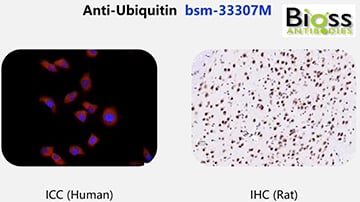Many of you who have done immunohistochemistry (IHC) staining are familiar with antigen retrieval. This seemingly simple step has a significant impact on IHC experiments and often determines the success of IHC assays. Bioss summarized a series of tips for you as a scientific expert, from retrieval buffers, boiling devices, retrieval methods, and matters needing attention. We hope these small details can improve your IHC experiences and extend your scientific research life to be successful.

Antigen retrieval is an essential step for formaldehyde-fixed paraffin-embedded (FFPE) sections. Since the fixation process creates methylene bridges between amino acids leading to cross-linking of proteins, antigens (epitopes) of interest might be masked, resulting in poor recognition (interaction) of primary antibodies. To solve this problem, methods used to restore antigenicity and enhance antibody-epitope binding are called antigen retrial, and two commonly used methods are heat-induced antigen (epitope) retrieval (HIER) and Proteolytic Induced Epitope Retrieval (PIER).
Heat-Induced Epitope Retrieval (HIER)
- Antigen Retrieval Buffer
There are a variety of buffers suitable for HIER, and we recommend two commonly used buffers: 10 mM citrate buffer (pH 6.0) and 0.5 mM EDTA buffer (pH 8.0).
Citrate Buffer (10mM Sodium Citrate, 0.05% Tween 20, pH 6.0):
Tri-sodium citrate (dihydrate) --------- 2.94 g
Distilled water ------------------------ 1000 ml
Mix to dissolve. Adjust pH to 6.0 with 1N HCl and then add 0.5 ml of Tween 20 and mix well. Store this solution at room temperature for 3 months or at 4 °C for longer storage.
Note: This buffer is commonly used and works perfectly with many antibodies. It gives very nice intense staining with a very low background.
EDTA Buffer (1mM EDTA, 0.05% Tween 20, pH 8.0):
EDTA (CAS# 6381-92-6) ---------------- 0.37 g
Distilled water -------------------------- 1000 ml
Mix to dissolve. Adjust pH to 8.0 using 1N NaOH. Then add 0.5 ml of Tween 20 and mix well. Store this solution at room temperature for three months or at 4 °C for longer storage.
Note: This buffer works excellent for many antibodies, but it often gives high background staining (maybe due to endogenous biotin revealed after this pretreatment). So primary antibodies can often be highly diluted. It is beneficial for low-affinity antibodies or when tissue antigens are not intense.
- Antigen Retrieval Methods
- 1. Place the pressure cooker filled with the appropriate antigen retrieval buffer on the hotplate and turn it on high (Do not close the lid tightly), then perform dewaxing and rehydration of sections.
- 2. Once the antigen retrieval buffer is boiling, put the slides into the pressure cooker and close the lid tightly.
- 3. After the pressure cooker reaches the maximum pressure (~121 °C), keep it for 3 minutes, turn off the hotplate and remove the pressure cooker.
- 4. Cool down the cooker with tap water and open the lid when the pressure drops. Remove the slides to room temperature (RT) and allow them to cool for 20 minutes.
Note: This method is highly recommended. Three minutes is only a suggested time. You can set up a control experiment, set 1, 2, 3, 4... minutes to explore and determine the best recovery time for your antigens of interest. In addition, please make sure that the slides are completely cooled before proceeding to the next step.
- Microwave Oven
Please use a research-grade microwave oven, although the household-grade device still holds a prominent place in the field of HIER. The most notable shortcoming of this method is to control the buffer temperature and the incubation time of slides.
1. Add the appropriate antigen retrieval buffer to a microwave-safe container.
- 2. Put the slides in the container and place them in the microwave oven. Set the temperature at 98°C for 20 minutes to retrieve the antigens (optimal incubation time should be determined by the user).
- 3. After 20 minutes, remove slides from the microwave oven and let them cool down for 10 minutes at RT.
Note: This method is convenient with drawbacks. In addition to the difficulties of regulating temperature, the longer retrieval time (20 minutes) may cause the sample dissociation from the slide. It is also crucial to ensure that the antigen retrieval buffer is sufficient to cover the slides (a few centimeters higher) to prevent drying out during “boiling”.
- Pre-heat water bath with staining dish containing appropriate antigen retrieval buffer until temperature reaches 95-100 °C.
- Immerse slides in the staining dish. Place the lid loosely on the staining dish and incubate for 20-40 minutes (optimal incubation time should be determined by the user).
- Turn off the water bath and remove the staining dish to room temperature and allow the slides to cool for 20 minutes.
Note: The primary drawback of water baths is the inability to achieve retrieval temperatures above 100 °C, resulting in more extended protocols and several retrieval buffer evaporations during the process. Therefore, it is critical to ensure that the antigen retrieval buffer is sufficient to cover the slides (a few centimeters higher) to prevent drying out during “boiling”.

Proteolytic Induced Epitope Retrieval (PIER)
Trypsin is widely used for FFPE tissue sections, thus enhancing the staining intensity of antibodies.
Trypsin Working Solution (0.05%):
Trypsin ---------------------------------- 5 mg
Calcium chloride -----------------------10 mg
Distilled Water --------------------------10 ml
Mix to dissolve. Adjust pH to 7.8 with 1N N NaOH. Store at 4 ºC for one month or -20 ºC for long term storage
- Preheat the trypsin working solution to 37°C.
- Cover sections with trypsin working solution (usually 50-100ul) and incubate for 10-20 minutes at 37 °C in a humidified chamber (optimal incubation time may vary depending on tissue type and degree of fixation and should be determined by the user).
- After that, take out the slide and rinse with running water for 3 minutes to cool down to room temperature.
Note: Place slides on a plastic rack in the humidifier chamber to avoid touching directly the metal rack of the incubator. Otherwise, the staining quality will be affected by uneven temperature.
